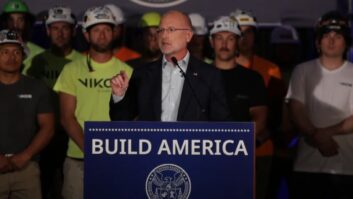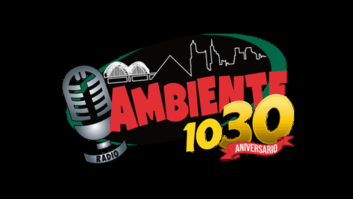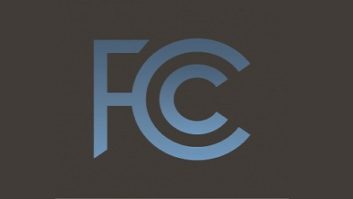PHILADELPHIA Discussion of the controversial elevated power increase proposal was at the forefront of IBOC news from the recent NAB Radio Show, while portable receivers — some available now on store shelves, others soon to be — garnered attention in iBiquity’s booth. After the show, the power hike story continued to evolve.
Here is a sampling of IBOC news from the convention.
Intense Talk About Power Focuses on 6 dB, for Now
IBiquity and NPR said they were working toward a compromise recommendation on the FM IBOC elevated power issue, one in which stations voluntarily could raise digital power by 6 dB as an interim step towards a full 10 dB jump.

Panelists in a session about elevated digital power pose for the RW camera. Photo by Jim Peck None had been reached by the end of the show, but shortly afterwards NPR told the FCC it believes a 6 dB interim increase could be implemented to increase digital coverage if sufficient safeguards and other measures are implemented.
It stressed those should include expedited development of HD technology to permit asymmetrical side band transmission, single-frequency boosters and a low-bitrate coder for radio reading services, as well as an enhanced remediation process to address harmful interference resulting from high-power HD operations. In describing its findings to the FCC after the convention, it used cautionary language about interference in certain cases.
HD Radio developer iBiquity and the so-called “joint parties,” major radio groups that have invested in the technology, want an increase. But NPR has differed with them over how much of a boost could be implemented without hurting the analog signals of radio stations. The 6 dB increase to –14 dB digital power had been suggested by iBiquity pending further consideration of a 10 dB hike.
Before and after the show, iBiquity lobbied several commissioners and pressed the FCC to approve such an intermediate increase. NPR and the joint parties also had differed on the timing of any increase, as NPR wanted to wait for initial test results before making a recommendation to the FCC.
In Philly FCC staff sounded ready to move on the issue. Audio Division Chief Peter Doyle said they intended to provide options to new Media Bureau Chairman Bill Lake for the chairman soon and urged all parties to tell the FCC what they would like to see in rules governing an increase.
Doyle said it’s clear to the commission that the current power level “is fraught with problems” and he said the agency has seen a slowdown in the number of notifications from stations converting to IBOC. And while the commission has received interference complaints, “most of them have been for listeners outside the protected contour,” he said. “There is no formal complaint before us.”
During a session on the elevated power issue, iBiquity Director of Broadcast Business Development Jeff Detweiler said iBiquity did endorse NPR’s proposal of asymmetrical IBOC power and single-frequency network digital boosters as ways to increase digital coverage.
NPR has put forth specific formulas for how non-commercial and commercial stations could increase their digital FM IBOC power.
Detweiler also ticked off a list of concerns iBiquity had about the latest NPR Labs testing, though he stressed the company had not yet had a chance to review the NPR data.
Potential issues with the mobile testing were that only one type of car was used and that test participants sat in the passenger seat, rather than the driver seat, where they “might be less focused on the audio.”
Representatives from iBiquity and the Joint Parties sit on a review panel that helped NPR shape the tests; Detweiler did not explain why iBiquity subsequently had qualms about the tests. However, “If we don’t get something significant, the industry won’t move on this. Three dB won’t be enough,” he said.
Transmission manufacturers who spoke at the session said a power increase is critical to keep the HD Radio rollout from stalling out.
“Unless we can figure out a way for broadcasters to make back their investment, this may be a futile effort,” said Tim Bealor, vice president for sales at Broadcast Electronics. He said his company would like to see some monetization of IBOC services.
Mike Troje, sales manager for Continental Electronics, agreed. “It’s a task to come up with what the right responses are for the industry when we don’t know what the end game is.” He added that market penetration for HD Radio is about 20 percent of stations and consists mostly of FMs.
“Just raising the power of HD is not going to solve this,” Troje continued. “If this stagnates, we all lose. We need action from the FCC.” The next group of adopters, such as small-market stations and mid-market groups, need to see a reliable business model, he and Bealor said.
“We need more receivers and for HD to be standard in cars. For five years I’ve been hearing, ‘Show me the Ford dealer who’s got it in their cars and I’ll buy an HD transmitter,'” Troje said.
Doyle of the FCC also said the agency is looking for ways to manage the power increase responsibly and is now considering possible notification procedures or application categories, as well as “better complaint procedures.” He urged broadcasters to contact the commission with suggestions, presumably via e-mail and/or filed comments to MB Docket 99-325.
NPR Labs Finds Impact on Lightly Processed Formats in Cars
The results had not been fully analyzed as of early October, but NPR Labs said its summertime tests into the impact of a 6 or 10 dB power hike raise concerns about the impact on certain listeners, specifically those in moving cars and those listening to lightly processed formats on first-adjacent closely spaced stations.
In a meeting with FCC Media Bureau staff, NPR executives summarized their test findings, including an overarching conclusion that “high-power HD Radio would uniquely cause significant first-adjacent analog interference to more closely spaced NCE-FM stations within the station’s protected service contour.” That’s according to an ex parte filing with the commission on Oct. 8.
“This is all about determining the impact of FM IBOC at higher power levels, especially for closely spaced stations,” said Mike Starling, vice president and chief technology officer, NPR and executive director at NPR Labs.
At a meeting of the Association of Public Radio Engineers preceding the convention, he characterized the bits and pieces gleaned so far from the studies as leading to a “strawman of what might be a managed power level policy,” meaning an initial conclusion to be massaged by peers and industry advisors for a final recommendation to the FCC.
NPR intended to give the commission “top-line” results in October. It planned to give full results both to the agency and CPB, which funded the studies, in mid-November.
NPR Labs is crunching these numbers to determine actual population impact assessment scenarios. Closely spaced stations would be affected most by elevated power levels, and the engineers are trying to determine the potential population that would be affected if specific adjacent stations were to go for a blanket digital power increase of 6 or 10 dB.
Based on the initial results of the listening tests, listeners noticed interference in the audio, with nearly half of those surveyed indicating they would turn off the radio when the power was turned up to –14 dB and –10 dB on lightly processed formats, such as news and classical music, in some portions of a coverage area, according to Dr. Ellyn Sheffield of NPR Labs and Towson University.
The problems were noted on some formats and in some cases, within the 6 dB to 20 dB desired/undesired signal power ratio, inside the protected coverage contour.
Researchers saw most of the effect at 60 miles per hour in cars, Starling said.
In contrast, commercial radio high-density (highly processed) music produced good results, he noted, as road noise decreased listener sensitivity to IBOC interference.
Nearly 100 noncommercial public radio stations operate in the “non-reserved” section of the band — i.e., from 92.1 to 107.9 MHz. Interference-resolution scenarios must be included in whatever the FCC approves, NPR and its member station advisory group believe.
A peer review group made up mostly of public station engineers will have input into the NPR report that goes to the FCC. The report will include text of the technical differences the working group and NPR had on the methodology and the scope and NPR’s response in terms of how it chose to frame and conduct the study.
The working group that helped to shape the test plan included Greater Media, CBS, Clear Channel, Harris, iBiquity, CEA and others.
Lake Promises Action on Power Increase
Before he became the new Media Bureau Chief, Bill Lake was involved with shepherding the DTV transition. In a session at the show, Lake promised his staff would try to “turn to the power increase sooner rather than later.”
He did express relief that the commission doesn’t face a hard date to enact digital radio like it did with television, but said of IBOC in general: “We want to promote it and encourage its adoption.”
Recognizing the pending power increase proceeding, now awaiting action by the commission for over a year, he said the FCC would get to it “as soon as we can. It’s not going to languish.”
Portable HD Radio Featured
IBiquity Digital had several new demos and products on the exhibit floor. In addition to the new Zune HD and Insignia HD portables, two HD Radio iPod and iPhone accessories from Gigaware were featured that enable the user to use iTunes Tagging to tag songs for later purchase and download. The Gigaware 120-0645 attaches to the bottom of an iPod, while the 120-0646, which includes a remote control, sits on a cable between the iPod and the ear buds. The Gigaware accessories are expected to be available by the holiday season.
The company also displayed personal navigation demos showcasing HD Radio’s real-time traffic capabilities, including a prototype of the first commercially available portable navigation device from Cydle with a built-in HD Radio receiver and real-time traffic updates from Total Traffic Network. The unit also features an electronic program guide that displays station and program information.
Also featured was a prototype vehicle power adapter with built-in HD Radio receiver from Kiryung Electronics displaying Navteq Traffic.






